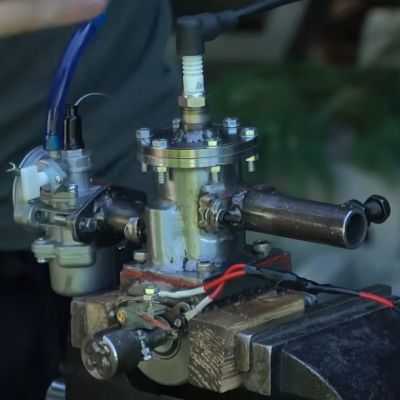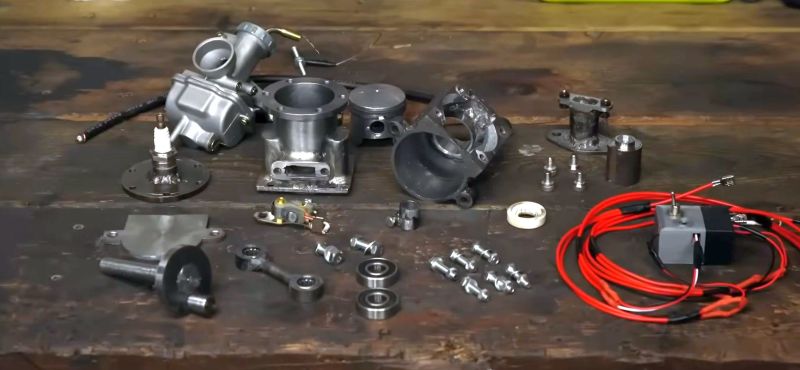
How hard could it to be to build a two-stroke internal combustion engine (ICE) from scratch? This is a challenge that [Camden Bowen] gladly set for himself, while foregoing such obvious wastes of time like first doing an in-depth literature study on the topic. That said, he did do some research and made the design in OnShape CAD before making his way over to the hardware store to make some purchases.
As it turns out, you can indeed build a two-stroke engine from scratch, using little more than some metal piping and other parts from the hardware store. You also need a welder and a lathe, with [Camden] using a Vevor mini-lathe that totally puts the ‘precision’ in ‘chatter’. As building an ICE requires a number of relatively basic parts that have to move with very little friction and with tight tolerances, this posed some challenges, but nothing that some DIY spirit can’t fix.
In the case of the very flexible boring bar on the lathe, improvising with some sturdy metal stock welded to a short boring bar resolved that, and precision was achieved. Together with an angle grinder, [Camden] was then able to manufacture the crank case, the cylinder and crank shaft and all the other pieces that make up an ICE. For the carburetor he used a unit off Amazon, which turned out to have the wrong throat size at 19 mm, but a 13 mm version worked. Ultimately, the first ICE constructed this way got destroyed mostly by running it dry and having the starter fluid acting as a solvent, but a full rebuild fixed all the issues.
This second attempt actually ran just fine the first time around, with oil in the crank case so that the poor engine wasn’t running dry any more. With a 40:1 fuel/oil mixture the little engine idles and runs as well as a two-stroke can, belching blue smoke and making a ruckus. This answers the question of whether you can build a two-stroke ICE with basic machining skills and tools, but of course the question that’s now on everyone’s lips is whether a four-stroke one would be nearly as ‘easy’. We wait with bated breath.















Making your own engine has been a thing for far longer than that.
Ford built his first engine out of scrap, and connected it to a light bulb socket to make the spark. That was in 1893.
https://www.thehenryford.org/collections-and-research/digital-collections/artifact/224715/#slide=gs-240148
True,but don’t make it sound like you found a cure for cancer!
That’s so cool! Very well done!
I can’t help but wonder if one could get by without the power tools – after all, the goal here is “working” not “optimized”.
Would be fascinating to just like, hand-finish some off-the-shelf pipe with sand paper, etc.
The carb isn’t exactly the most complicated machine either, maybe manufacturing that with hand tools might be harder, but it didn’t need to be a COTS part.
Either way, I find this impressive – using tools and off the shelf parts isn’t cheating – for a first round…
You’ll never get parts smooth or round enough with only hand tools. Machining preceded steam engines for a reason.
Newcomen steam engine had such poor tolerances that rope with tallow, and similar contrivances, were used as piston rings. Precise machining was in the future.
Well, it would certainly be more impressive without the use of a lathe as implied by the headline.
Making an engine without a lathe is literally impossible. there is absolutely no other way to form a smooth enough piston bore without one.
found another way? congratulations, you’ve invented a lathe from first principles.
I’d find it more questionable that he’s using off-the-shelf pistons, but maybe one day he can swap that out too.
I think Henry fords sink engine would like a word. Plenty of engines exist using some rudimentary piston that wasn’t made by a lathe at all. Just had reasonable tolerances. Seems to me the title insinuating that they used hardware store parts is the issue, considering machine shop tooling is used.
Not so sure about that – Ford was working for Edison at the time (as chief engineer) and probably would have had access to a lathe.
Here’s a fairly thorough examination of the engine in question:
https://sites.google.com/site/lagadoacademy/machining—lathes-mills-etc/review—ford-s-first-engine
His “sink engine” was a desktop novelty with pitifully little power. The word “reasonable” is doing a lot of heavy lifting there. Without real, tightly-controlled tolerances it’s impossible to develop any meaningful compression.
(This is also conveniently ignoring the fact that Ford built his engine model from scraps with unknown provenance, which may have been machined even if Ford wasn’t the one who did it)
There are very low power low temperature rocking Stirling engines, but they are very very low power. But they are engines (solar powered)
Low power is the operative word. Without a lathe the required tolerances for an internal combustion engine of any meaningful power in any reasonable size are impossible.
Eh, technically you could get higher power output than those from oscillating combustion with just moving fluids, especially if efficiency doesn’t matter. Pulse jets just make thrust, but can be made of anything, and you could always let it thrust in a circle. The fluidyne stuff was external combustion, but internal ought to be possible. Maybe you could make one using alcohol. Power in the form of pulses will, using check valves, mean pumped fluid. Can always turn that into shaft power too, without needing to seal especially well, again as long as efficiency doesn’t really matter. Or compressed air can spin various things fast, even without incredible tolerances.
I’m just saying, “literally impossible” is bound to have exceptions. Maybe something with pre-machinery firearms, which are basically the same thing. Or just the general way that things could work together before interchangeable parts, sometimes by deliberate wear that matched two items up, regardless of whether you had a ground truth for flatness or concentricity or whatever available. Is a pottery wheel a lathe?
A hardware store that services the lawnmowers, chainsaws, weedeaters, and etc. that they sell?
B^)
He bought the piston, the carb and the spark plug. I’d say that was quite a long way from ‘from scratch’.
Building your own engine wasn’t such an unusual thing back in the late 1890s to 1910s.
Somewhere in my library I have a book on building your own motorcycle from that era. Now I’m motivated to try to find it.
It gives full instructions on how to build your own engine, right down to making the mould to get the cylinder cast at your local foundry, you know, the foundry/blacksmith you used to get the lugs for your frame cast. :)
After that period better engines were more available off the shelf so there would have been less incentive to build from scratch, but still it’s amazing what a determined person with a hammer, chisel, file and wrench can do with boundless patience and raw materials.